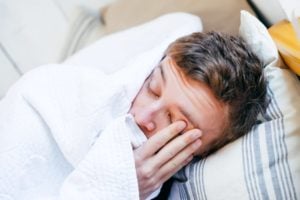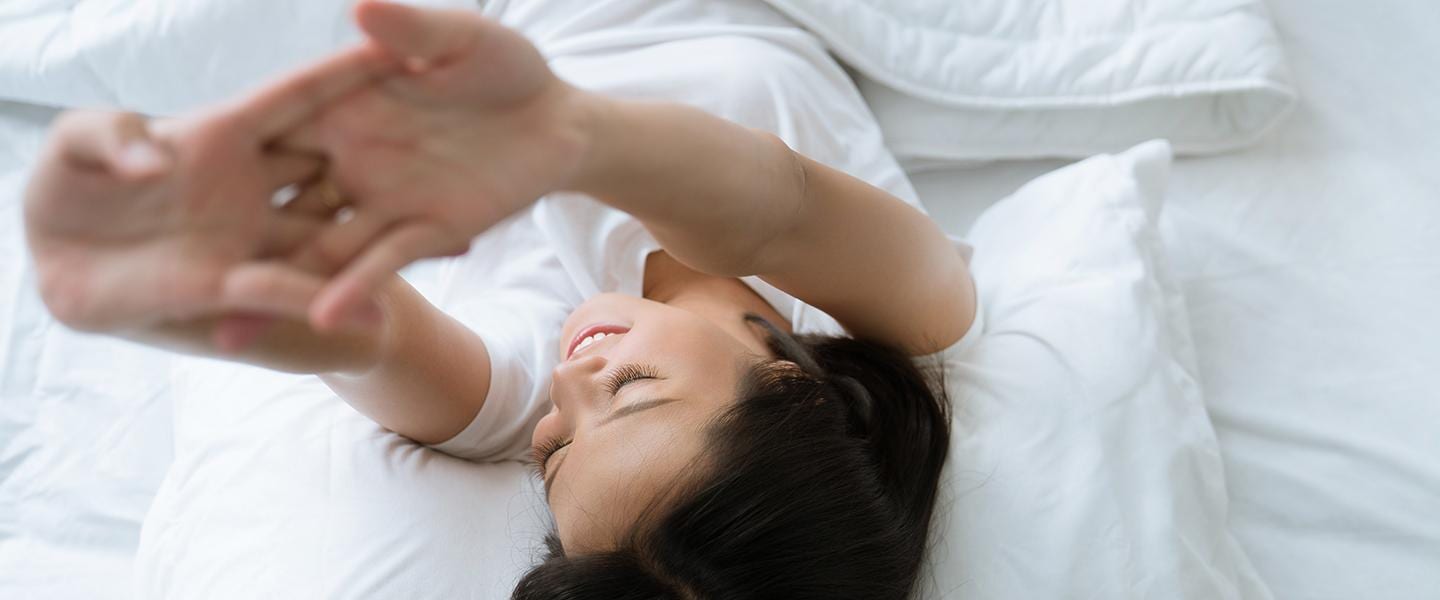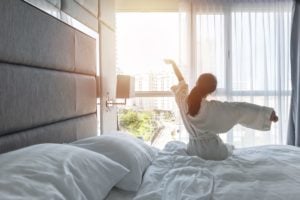How Electronics Affect Sleep
Tempting as it might be to use your computer or phone before bed, studies have shown these devices can interfere with sleep by suppressing the production of melatonin , a natural hormone released in the evening to help you feel tired and ready for sleep. This leads to neurophysiologic arousals that increase feelings of alertness when you should be winding down instead.
Why Do Electronic Devices Keep You Up?
The biological clock in healthy adults follows a 24-hour sleep-wake cycle . When the sun rises in the morning, your body produces cortisol, a hormone that makes you feel awake and alert. As daylight fades, the body releases another hormone, melatonin, that produces feelings of sleepiness.
Electronic back-lit devices like cell phones, tablets, readers, and computers emit short-wavelength enriched light, also known as blue light. Fluorescent and LED lights also emit blue light, which has been shown to reduce or delay the natural production of melatonin in the evening and decrease feelings of sleepiness. Blue light can also reduce the amount of time you spend in slow-wave and rapid-eye movement (REM) sleep, two stages of the sleep cycle that are vital for cognitive functioning.
Children are particularly vulnerable to sleep problems stemming from electronic devices that emit blue light. Numerous studies have established a link between using devices with screens before bed and increases in sleep latency, or the amount of time it takes someone to fall asleep. Additionally, children who use these devices at night often do not receive enough high-quality sleep and are more likely to feel tired the next day.
Certain types of household lighting can also affect melatonin production at night. One study found that bright bedroom lighting can decrease the nocturnal production of melatonin by as much as 90 minutes compared to dim lighting.
Unlike blue light, red, yellow, and orange light have little to no effect on your circadian rhythm. Dim light with one of these colors is considered optimal for nighttime reading. Portable e-readers like the Kindle and Nook emit blue light, but not to the same extent as other electronic devices. If you prefer to use an e-reader such as a Kindle or Nook, dim the display as much as possible.
Tips for Using Technology at Night
We recommend avoiding computers, smartphones, and other blue light-emitting devices in the hours leading up to bedtime. However, this may not be an option for certain people, such as those who work or study at night. If you need to use one of these devices in the evening, the following strategies can help you sleep longer and better.
- Decrease Your Daytime and Nighttime Electronics Use: Using electronic devices for long periods during the day can negatively impact sleep too, especially among adolescents. Common effects include shorter sleep duration, longer sleep onset, and more sleep deficiency. Talk to your teenagers about excessive electronics exposure and, if need be, impose restrictions on their daily use.
- Establish a Relaxing Bedtime Routine: A regular bedtime that ensures an adequate amount of rest is essential for healthy sleep. The hour before bed should consist of relaxing activities that don’t involve devices with screens.
- Make Your Bedroom a Screen-Free Zone: While a lot of people prefer to keep a television in their bedroom, watching TV before bed is generally discouraged due to the negative effect it can have on your sleep. In fact, we recommend removing all of your electronic devices from your bedroom – and encourage your kids to do the same.
- Keep the Bedroom Lights Dim: Light intensity is measured in a unit known as lux. Some studies have shown that normal indoor light levels of 100 lux or more can suppress melatonin production and interfere with your sleep-wake schedule. Dimmer indoor lighting affects your melatonin production to a much lesser extent.
- Use Nighttime Mode: Many cell phones, tablets, and other portable electronic devices are equipped with a “nighttime mode” that is easier on the eyes before bed. As one study noted, the most effective nighttime modes reduce blue light emissions and decrease the display’s brightness setting. You should manually dim the display if your device does not automatically adjust the brightness in nighttime mode.
- Invest in Some “Blue Blocker” Glasses: You can purchase orange-tinted eyeglasses specifically designed to shield your eyes from blue light emissions. This may not be ideal, especially if you don’t like wearing glasses, but some studies have found them to be very effective. Blue light blocking glasses are relatively inexpensive, and you should be able to find a decent pair for less than $100.
References
8 Sources
-
Shechter, A., Kim, E. W., St-Onge, M., & Westwood, A. J. (2018). Blocking nocturnal blue light for insomnia: A randomized controlled trial. Journal of Psychiatric Research, 96, 196–202., Retrieved from
https://pubmed.ncbi.nlm.nih.gov/29101797/ -
Gringras, P., Middleton, B., Skene, D. J., & Revell, V. L. (2015). Bigger, Brighter, Bluer-Better? Current Light-Emitting Devices – Adverse Sleep Properties and Preventative Strategies. Frontiers in Public Health, 3, 233., Retrieved from
https://pubmed.ncbi.nlm.nih.gov/26528465/ -
National Institute of Neurological Disorders and Stroke. (2019, August 13). Brain basics: Understanding sleep., Retrieved October 26, 2020, from
https://www.ninds.nih.gov/health-information/public-education/brain-basics/brain-basics-understanding-sleep -
Centers for Disease Control and Prevention. (2020, April 1). The Color of the Light Affects the Circadian Rhythms., Retrieved October 26, 2020, from
https://www.cdc.gov/niosh/emres/longhourstraining/color.html -
Hale, L., Kirschen, G. W., LeBourgeois, M. K., Gradisar, M., Garrison, M. M., Montgomery-Downs, H., Kirschen, H., McHale, S. M., Chang, A., & Buxton, O. M. (2019). Youth screen media habits and sleep: sleep-friendly screen-behavior recommendations for clinicians, educators, and parents. Child and Adolescent Psychiatric Clinics of North America, 27(2), 229–245., Retrieved from
https://pubmed.ncbi.nlm.nih.gov/29502749/ -
Gooley, J. J., Chamberlain, K., Smith, K. A., Khalsa, S. B. S., Rajaratnam, S. M. W., Van Reen, E., Zeitzer, J. M., Czeisler, C. A., & Lockley, S. W. (2011). Exposure to Room Light before Bedtime Suppresses Melatonin Onset and Shortens Melatonin Duration in Humans. The Journal of Clinical Endocrinology & Metabolism, 96(3), 463–472., Retrieved from
https://pubmed.ncbi.nlm.nih.gov/21193540/ -
Hysing, M., Pallesen, S., Stormark, K. M., Jakobsen, R., Lundervold, A. S., & Sivertsen, B. (2015). Sleep and use of electronic devices in adolescence: results from a large population-based study. BMJ Open, 5(1)., Retrieved from
https://pubmed.ncbi.nlm.nih.gov/25643702/ -
Nagare, R., Plitnick, B., & Figueiro, M. G. (2018). Does the iPad Night Shift mode reduce melatonin suppression? Lighting Research & Technology, 51(3), 373–383., Retrieved from
https://pubmed.ncbi.nlm.nih.gov/31191118/














































